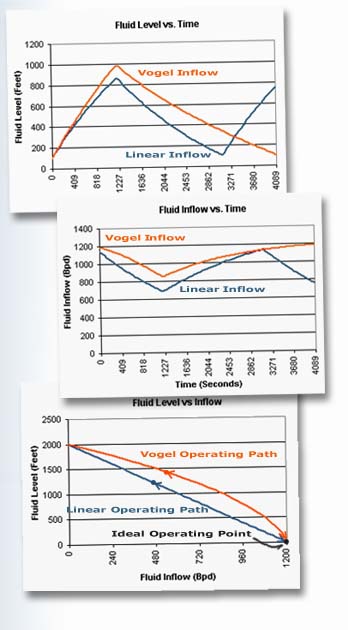
|
Cut energy costs by timing operations around utility rates. |
||
|
View our latest offerings at two trade shows. |
||
|
Measure beam angle and acceleration. |
||
|
Assess lost production due to pump-off control. |
||
|
Watch for these topics in upcoming issues. |
||
| Printer-Friendly Version | |
| Send to a Friend | |
| · Subscribe | |
| · Unsubscribe | |
![]()
| · Issue 10 | · Issue 5 |
| · Issue 9 | · Issue 4 |
| · Issue 8 | · Issue 3 |
| · Issue 7 | · Issue 2 |
| · Issue 6 | · Issue 1 |
![]()
Oil & Gas Automation
Solutions is a publication
of Unico, Inc.
Unico, Inc.
3725 Nicholson Rd.
P. O. Box 0505
Franksville, WI
53126-0505
262.886.5678
262.504.7396 fax
oilgas@unicous.com
unicous.com
Copyright © 2004
Unico, Inc.
All rights reserved.
All trade designations
are provided without
reference to the rights of
their respective owners.
|
| Rate |
Summer
|
Winter
|
|
| On-Peak Energy ($/kWh) |
$0.14294
|
$0.04661
|
|
| Off-Peak Energy ($/kWh) |
$0.04088
|
$0.03706
|
|
| On-Peak Demand ($/kW/month) |
$2.70
|
$0.00
|
|
| Maximum Demand ($/kW/month) |
$6.55
|
$4.40
|
Distribution of Utility Cost vs. Production Hours
In this case, the operator could give up 762 hours of peak summer operation or 8.7% of the total available hours and save $4,692 per year or 24.2% of his utility bill.
Unico artificial-lift drives incorporate a time-of-use control that facilitates these kinds of savings. For more information, please contact us.
![]()
Unico to Exhibit at the Southwest Petroleum Short Course and Four-Corners Oil Show
 Unico will be exhibiting a number of its new products at the Southwest Petroleum Short Course in Lubbock, Texas, on April 21-22 and at the Four-Corners Oil and Gas Conference in Farmington, New Mexico, on May 12-13. Products to be showcased include our sophisticated sucker-rod (SRP), progressing
Unico will be exhibiting a number of its new products at the Southwest Petroleum Short Course in Lubbock, Texas, on April 21-22 and at the Four-Corners Oil and Gas Conference in Farmington, New Mexico, on May 12-13. Products to be showcased include our sophisticated sucker-rod (SRP), progressing cavity (PCP), and electric submersible (ESP) controllers with enhanced features, our new variable-voltage drive, the Unico Well Monitor, remote communications options, and much more. We hope to see you there.
cavity (PCP), and electric submersible (ESP) controllers with enhanced features, our new variable-voltage drive, the Unico Well Monitor, remote communications options, and much more. We hope to see you there.
![]()
New Inclinometer Provides Beam Angle and Acceleration in a Compact Package
|
|
||||||||||||||||||||||||||||||||||||||||||||||||||||||
|
directly from beam angle or indirectly from pumping-unit geometry, beam zero crossing, and motor rotation. Beam acceleration is useful for diagnostics and for improving the dynamic regulation of the rod-stroking motion. For information on the inclinometer and its use in rod-pumping applications, please contact us. New Pump-Off Control (POC) Calculator Estimates Lost Production
|
||||||||||||||||||||||||||||||||||||||||||||||||||||||
|
These losses can be virtually eliminated with the use of a variable-speed drive. The bottom chart shows the operating paths for linear and Vogel characteristics during the pump on/off cycle. Unico variable-speed drives maximize well production by maintaining fluid level at the ideal operating point. Try the POC Calculator™ at |
||||||||||||||||||||||||||||||||||||||||||||||||||||||
Example POC Calculation
|
||||||||||||||||||||||||||||||||||||||||||||||||||||||
| Input Parameter |
Value
|
Results | Value | |
| Fluid Density (psi/ft) |
0.433
|
Linear Average Flow (bpd) | 1006 | |
| Casing Diameter (in) |
5.000
|
Linear Lost Production (%) | 16.2 | |
| Tubing Diameter (in) |
2.875
|
Vogel Average Flow (bpd) | 1079 | |
| Reservoir Static Head (ft) |
2000
|
Vogel Lost Production (%) | 10.1 | |
| Reservoir Maximum Flow (bpd) |
1200
|
|||
| Pump Stop Head (ft) |
0
|
|||
| Pump Output Flow (bpd) |
1500
|
|||
| Pump Off Time (s) |
1000
|
In Future Issues...
Look for the following articles in upcoming issues of Oil & Gas Automation Solutions:
| Using a torque economizer mode to improve efficiency and reduce gearbox stress | |
| Reducing power consumption and improving power factor of beam pumps | |
| Field tests of methods to eliminate rod pump gas locking and interference | |
| Detecting stick/slip oscillations that fatigue rod-string couplings and reduce energy efficiency of PCPs |
 Taking Advantage of Utility Rate Structures to Reduce Artificial-Lift Energy Costs
Taking Advantage of Utility Rate Structures to Reduce Artificial-Lift Energy Costs Unico is introducing a cost-effective inclinometer that measures beam angle and acceleration for about the price of a proximity switch. The compact, weatherproof unit mounts easily to a pump-jack beam and provides ±30° beam angle measurement, a 0° crossing logic signal, and beam acceleration measurement. Rod position can be determined
Unico is introducing a cost-effective inclinometer that measures beam angle and acceleration for about the price of a proximity switch. The compact, weatherproof unit mounts easily to a pump-jack beam and provides ±30° beam angle measurement, a 0° crossing logic signal, and beam acceleration measurement. Rod position can be determined Unico now provides an online POC Calculator™ to evaluate the effect of pump-off control settings on well production. The calculator supports both linear and Vogel inflow characteristics. The table below and charts at left illustrate the substantial loss of production for a typical set of well parameters.
Unico now provides an online POC Calculator™ to evaluate the effect of pump-off control settings on well production. The calculator supports both linear and Vogel inflow characteristics. The table below and charts at left illustrate the substantial loss of production for a typical set of well parameters.